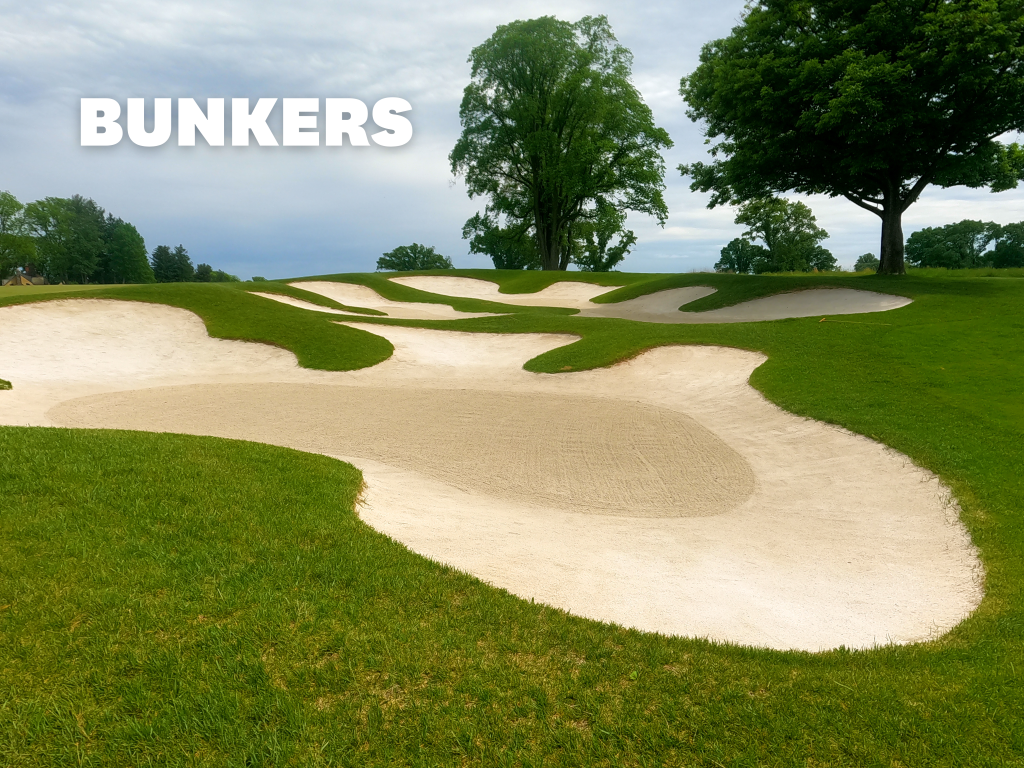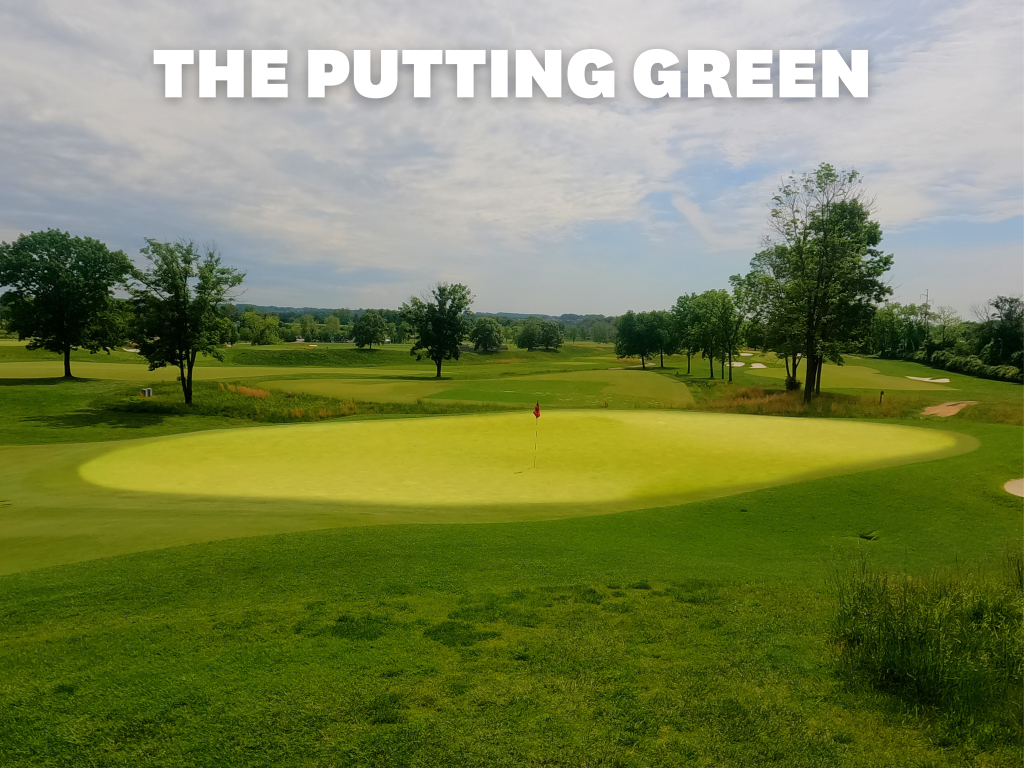The course, the place where you play the game of golf, is everything within any boundaries that may be in place and is split into five distinct areas: the teeing area, bunkers, penalty areas, the putting green and the general area.
In addition to the five areas of the course, there is one additional area not on the course that you need to know about – out of bounds.
Knowing which area of the course your ball lies in is important for determining the options available for a player. For example, if your ball lies in a penalty area you won’t be allowed to take free relief from abnormal course conditions. But to know where the ball lies, you need to know how each area of the course is actually defined.
The Teeing Area: This is the starting place for the hole being played. Therefore, on any given hole, there is only one teeing area at a time.

The teeing area is a rectangle that is two club-lengths in depth, measured from the outermost and front edges of the tee markers. The width is determined by the placement of the tee markers.
Your ball is in the teeing area when any part of it touches the teeing area or is above any part of the teeing area (when on a tee, for example).
Bunkers: These are areas that have been hollowed out and then filled with sand or a similar substance.
Sometimes casually referred to as “sand traps,” these are considered a less penal area than penalty areas, but do have special restrictions regarding touching the sand before a stroke.

Most bunkers are easily defined by the edges of the turf surrounding the bunker. Non-grass covered walls and grass-covered areas bordering or within the bunker are not part of the bunker.
Your ball is in the bunker when any part of it touches the sand (or where sand would be) on the ground inside the bunker or if it lies on top of something on sand in the bunker. For example, if your ball lies on top of a leaf or rake that is lying in the bunker, your ball is in the bunker. If your ball overhangs a bunker, but does not touch the sand, it is not in the bunker.
Penalty Areas: These include any sea, lake, pond, ditch, surface-drainage ditch or other open watercourse, whether or not it is actually containing water at the time or any other area defined as such by the Committee. Penalty areas are further split into yellow and red penalty areas, and the color determines which relief options are available to you when your ball is in a penalty area.

Penalty areas are defined by stakes, lines or physical features. When only stakes are used, the outermost edges of the stakes at ground level define the edge of the area. When lines (or both stakes and lines) are used, the lines are what define the edge. Penalty area edges extend vertically upward and downward, so if your ball is in a branch overhanging a penalty area, it is considered in the penalty area. Additionally, penalty areas can be defined as yellow or red.
The Putting Green: This is the place on the hole being played specially prepared for putting and where the hole is placed. On any given hole, there is only one putting green at a time. Practice putting greens and the greens of holes not being played are considered wrong greens which are part of the general area.
The place specially prepared for putting is typically the shortest cut of grass on the course and is fairly distinct. There are rare occasions with sand courses that define sandy areas as putting greens. The putting green does not have edges that extend upward or downward, so in order for a ball to be on the putting green it must physically touch the putting green surface itself or be on top of an object that is on the putting green (like a leaf or wrapper).
The General Area: ”General area” is a catch-all term that encompasses everything EXCEPT the other four areas of the course. The general area includes fairway, fringes, rough, sandy areas that are not bunkers, pine straw, desert or forests. Anything on the course is in the general area, other than bunkers, penalty areas and the teeing area and putting green of the hole you are playing.
The general area is one of the hardest areas to define because it is everywhere another defined area of the course is not. A ball is in the general area when no part of the ball touches another area of the course and is still in bounds.
Out of Bounds: This is not actually a part of the course but is specifically everything NOT on the course as defined by the Committee. It is important to know what areas are out of bounds because you cannot play your ball from there.
Out of bounds can be defined by any number of features: stakes, lines, fences, walls, buildings, pavement, etc. Usually, it is clarified on the Notice to Players or course Local Rules if there is out of bounds and how it is defined. If stakes or lines are used, they are typically white in color.
Just like penalty areas, if lines are used, the line itself defines the boundary edge. If only stakes are used, the course-side edge of the stakes at ground level define the edge. The out of bounds edge also extends upward and downward, but a ball has to be completely beyond the edge before it is out of bounds. If any part of the ball is touching the course breaking the plane of that boundary edge (whether on the ground or overhanging in a tree), then it is not out of bounds.

| Area of the Course |
Edge |
Defined By… |
A Ball is in area when… |
| The Teeing Area |
Up |
Outside and front edges of tee markers – 2 club depth |
Any part of ball touches it or is above it |
| The Putting Green |
None |
Surface specially prepared for putting |
Any part of ball touches it |
| General Area |
None |
Anywhere on course except the other four areas. |
No part of ball touches another area and is not out of bounds |
| Bunker |
None |
Non-grass covered turf wall or edge, or as otherwise defined by the Committee |
Any part of ball touches sand (or where sand should be). |
| Penalty Area |
Up & Down |
Outside edge of Stakes or Lines, or physical feature |
Any part of ball touches it |
| Out of Bounds |
Up & Down |
Course-side edge of Stakes or Lines, or as otherwise defined by the Committee |
When no part of the ball touches the course (all of it is out of bounds) |
When Ball Touches More Than One Area: If the ball touches the general area and one of the other 4 specific on course areas (teeing area, bunker, penalty area, putting green), the ball lies in the specific area – not the general area.
If the ball touches multiple of the specific areas it lies on the area of the course following this priority: 1) penalty area, 2) bunker, 3) putting green.









